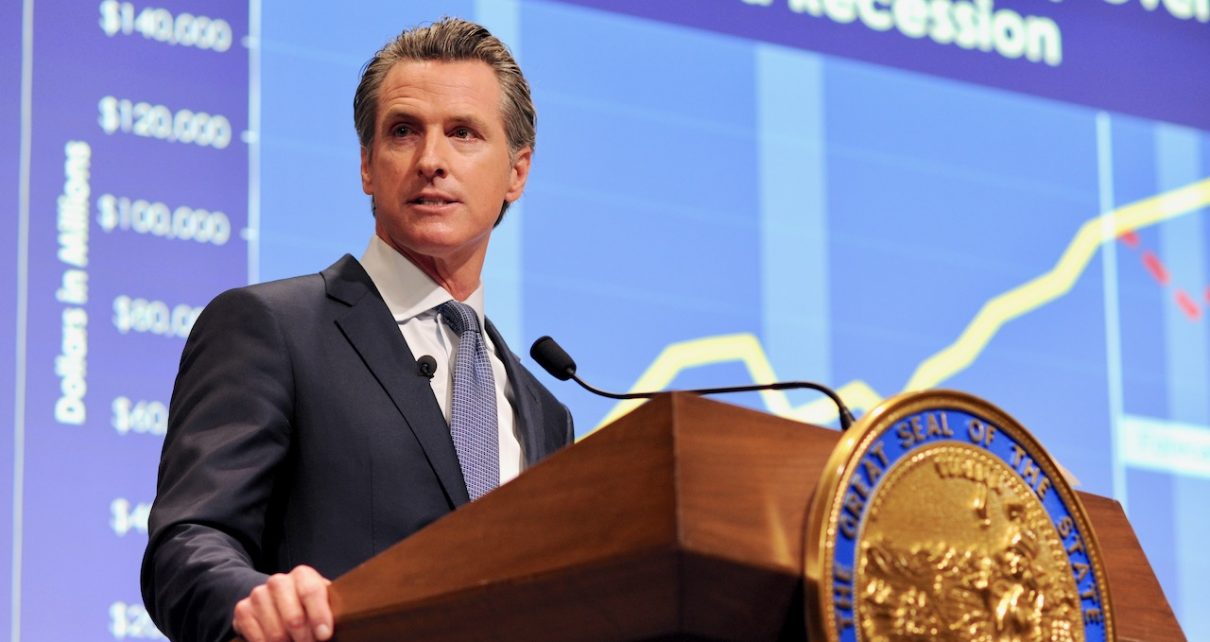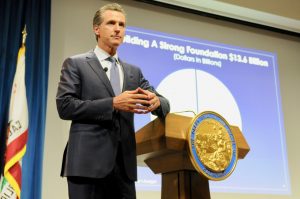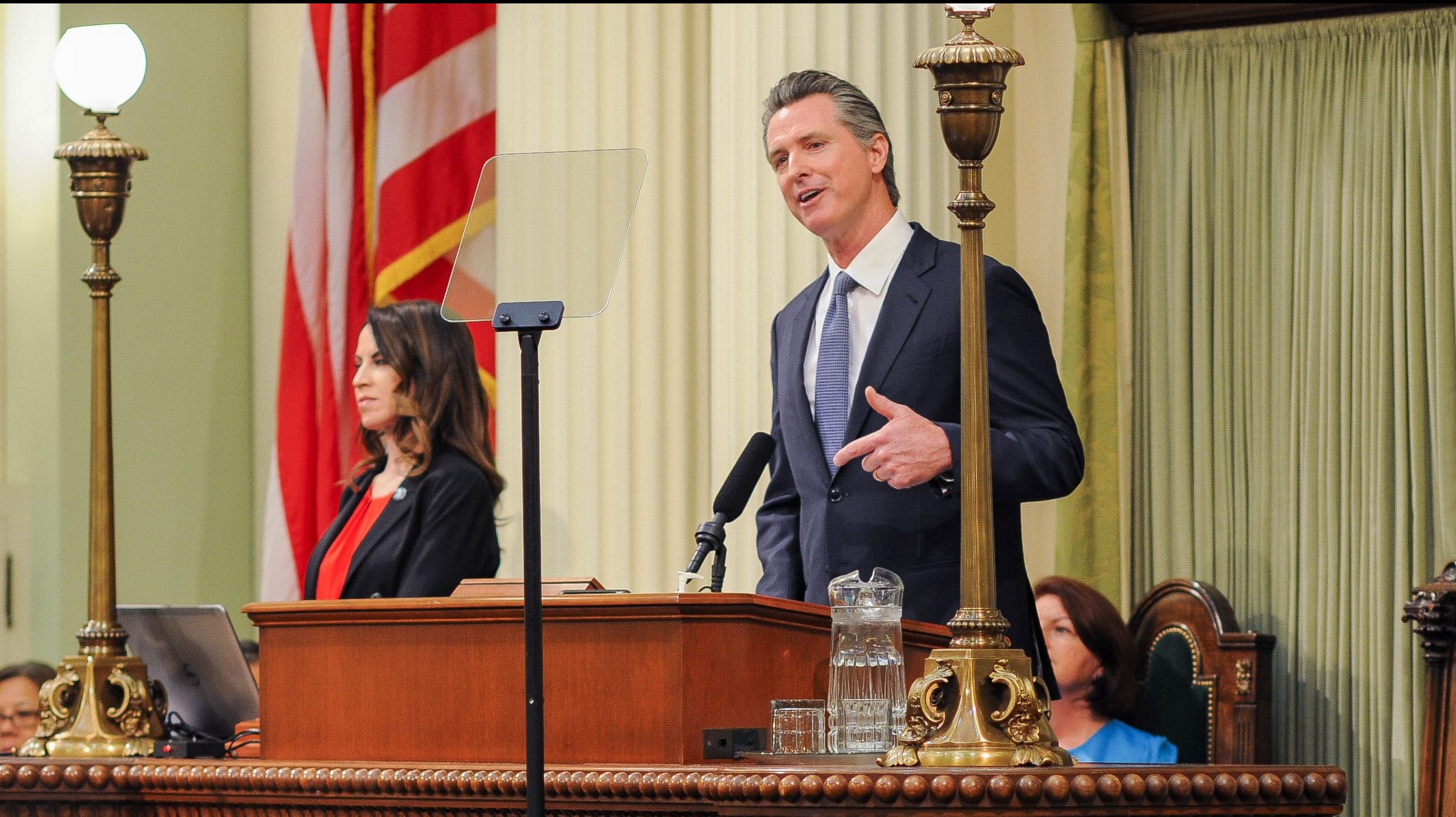
Gov. Gavin Newsom presents 2019 budget. (Photo: Kevin Sanders for California Globe)
What’s In Gavin Newsom’s 2019 ‘California For All’ Budget
Nearly 87 percent of Gov’s new spending is one-time ‘investments’
By Katy Grimes, January 11, 2019 5:00 am

Self-described policy wonk Gov. Gavin Newsom presented his first Budget Summary 2019-20 Thursday – all 178 pages of it. “Full disclosure, this is something I really enjoy,” Newsom said.
Newsom inherited a significant surplus of $15 billion and the fifth largest economy in the world “but an embarrassingly high child poverty rate, higher than it was before the Great Recession, CNBC reported recently.
Noting that the economy is slowing, Gov. Newsom said he’s anticipating a 2 percent average growth rate in the economy, so spending must be restrained. Yet the $209 billion budget shows an $8 billion, four percent increase from the 2018-19 budget.
When Gov. Jerry Brown returned to office in 2011, his state budget was $98 billion, and increased to $200 billion by 2018. This is a 110 percent increase in eight years, with a population increase of just three million. Based on the figures from the 2018-19 budget act, the state will have spent about $309 billion in total funds. Of that amount 35 percent (nearly $108 billion) is federal funds, including special funds: emergency FEMA funds, transportation funds, and Medi-Cal.
Of the $209 billion 2019-20 budget total, $144 billion is the general fund, a 3.6 percent increase from 2018-19. However, Newsom’s budget will include $13.6 billion to pay down the state’s unfunded pension obligations.
According to Newsom’s budget proposal to pay down the state’s unfunded pension liabilities, this includes:
- $4 billion investment that eliminates all outstanding budgetary debt as well as deferrals
- $4.8 billion to build reserves, bringing the state’s Rainy Day Fund to more than $15 billion this year (the largest amount ever) and nearly $20 billion over four years
- $4.8 billion to pay down unfunded retirement liabilities
Sen. John Moorlach (R-Costa Mesa), the Legislature’s only Certified Public Accountant and the guy responsible for bringing Orange County out of bankruptcy, commended Newsom for the one-time payment of $3 billion into CalPERS and $2.9 billion into CalSTRS over the next four years to reduce state pension and retiree medical liabilities, but also issued a warning: “That’s a great start, but hardly adequate to address the growing pension and retiree healthcare costs that state and local governments are now required to acknowledge in their Comprehensive Annual Financial Reports,” Moorlach said.
“A wise use of the surplus would pay for one-time investments to provide clean water, improve our infrastructure and pay down our state debt,” said Assemblyman Devin Mathis (R-Visalia), who has authored several bills to acquire funding for clean drinking water for his Central Valley constituents, only to have his bills killed. Newsom allotted $130 million in the budget for safe drinking water. “This is a disgrace!” Newsom said. “We need immediate relief.”
“Finally, I’m calling on Gov. Newsom to end the failed High-Speed Rail project,” Mathis said. “Every dollar we waste on the train to nowhere is a dollar we take away from police officers, firefighters and teachers who need our support.”
Newsom proposed $2 billion toward low-income children, specifically going for infrastructure and childcare facilities. Newsom said he was “concerned about our capacity to deliver on this. To get the facilities we will need to hire and train many – it may take three years. “
“I don’t want to over promise and under deliver,” Newsom added.
Newsom also proposed full day universal kindergarten. “One-quarter of our kids live in districts that don’t offer this,” Newsom said. He has allocated $750 million of one-time new spending to do this, which also covers “undocumented residents.”
Newsom’s budget includes more spending for all education, totaling 1.3 billion for higher education:
- California State University system – $562 million. Newsom said they started last year with $92 million. This is an 8 percent increase.
- University of California system – $393 million, for a 7 percent increase.
- At UC 60,000 people have dropped out without degrees. “The UC extension system is underutilized,” Newsom said. “We want the ‘near completes’ to get those degrees.” He’s allocated $15 million to set this in motion.
- $401 million for the California Community College system. “We are going to get that second year of free community college,” Newsom said. He said the state will provide legal services “for those young kids who are illegal and feeling anxiety.”
- State mandated Local Control Funding Formula: $63 billion
- $50 million in child savings accounts. Newsom wants every child entering into kindergarten to get a college savings account. “Even a small amount guarantees every kid goes to college,” Newsom said.
- Newsom said he wants a charter school transparency bill. “I’m not bashing charters, but they need transparency.”
Newsom said working parents who attend college and who have young children deserve relief Cal Grants of $6,000, up from about $1,100. “It’s the right thing to do.”
Newsom wants homelessness eradicated and treatment for those living on the streets. He’s budgeted $500 million into incentive-based programs, and $100 million for the “whole person care program.”
For jurisdictions with real plans in place, Newsom said there will be $300 million coming their way. Once jurisdictions have up and running programs, the remaining $200 million will come.
Newsom also said for local issues like affordable housing and homeless navigation centers, “If you can create CEQA waivers for stadium projects, we should be able to do that for the 100,000 souls on the street. Literally, people’s live are at stake.”
Newsom wants to convert unused state-owned properties into useful homeless navigation centers, and sell off the rest. He’s allocated funding to do an actual inventory to accomplish this.
As for the Department of Motor Vehicles, Newsom announced Wednesday he would expedite a performance audit into the DMV, along with a “DMV Reinvention Strike Team” to work to improve services. Former Gov. Brown had denied a performance audit of the DMV in August.
Newsom mocked the DMV for not accepting credit cards at their offices. “We’re going to accept credit cards,” Newsom said. “It’s a governor in 2019 in California saying that we’re going to accept credit cards in 2019 at the Department of Motor Vehicles. That is in the ‘you can’t make that up’ file.”
Newsom wants more DMV self-service terminals, as well as multi-function terminals in malls, libraries, and business centers.
“The Governor is acting more like a Chief Executive Officer than his predecessor,” said Sen. Moorlach. “Instead of giving the Department of Motor Vehicles whatever it takes to shorten the waiting lines, Gov. Newsom is sending in a strike team and implementing better management practices. This is very encouraging.”
On healthcare, Newsom already unveiled his health care plan to continue the Affordable Care Act, to include and expand coverage for health care for illegal immigrants and give the state new powers to negotiate pharmaceutical drug prices.
“It’s time for the individual mandate,” Newsom said. “The President is wrong, and California is right,” he said referring to Congress overturning the individual mandate in the Affordable Care Act, because it penalized people with a fine for not having health insurance.
“The revenue it generates will be used to subsidize people in poverty. Then we can expand eligibility from 400 percent to 600 percent through Covered California,” he added. However, this will need legislation. As for conflicting with the federal government on this, Newsom said that the Trump Administration has granted some states waivers, and said he feels California could also receive one. However, Newsom has not yet said how California will pay for this.







